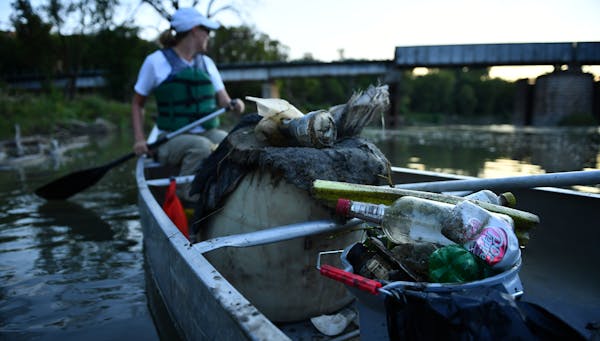Many lakes around the Twin Cities are becoming so salty from winter road maintenance that, within three decades, they will no longer support native fish and plants.
The lakes were included in the first study of freshwater chloride contamination across the northern region of the country, an area that has one of the highest density of lakes on earth. The researchers found that lakes showed steadily rising concentrations of chloride even with just one percent impervious land cover around their perimeters.
The Twin Cities turned out to be among the saltiest.
"One of the most impacted areas is Minneapolis and St. Paul, where you have dozens of small lakes," said Hilary Dugan, the lead researcher and a limnologist at the University of Wisconsin, Madison. "The smaller the lake, the more easily you load it with salt."
Altogether, researchers analyzed the salt histories of 371 lakes in 10 northern states and Ontario, Canada — 62 of which were in the Twin Cities metro area. The study was published Monday in the Proceedings of the National Academies of Science.
The study could provide new guidance for environmental campaigns in many northern states, including Minnesota, to use less salt. While many of those efforts focus on road and street agencies like MnDOT, Dugan said homeowners and private businesses are to blame for about half the salt used each winter. And no one knows how much they are using.
"When you put down salt on the sidewalk you should be thinking of teaspoons — not cups," she said. "All you need is a few crystals to work effectively on ice."
Minnesota's official list of impaired waters already includes 45 water bodies polluted with chloride, 39 of which are in the metro area where the high concentration of roads, sidewalks and parking lots get about 349,000 tons of road salt a year. The Mississippi River in the metro area is not yet polluted enough to violate federal standards, but a recent report showed that salt concentrations, mostly from road salt, have increased 81 percent since 1985.
"That's a dramatic increase in any kind of contamination," said Brooke Asleson, who manages the metro area salt reduction project for the Minnesota Pollution Control Agency.
Groundwater in the metro area is also affected, according to the Minnesota Pollution Control Agency, with almost a third of the monitoring wells in the area showing enough salt to affect aquatic life, and almost as many with enough to affect the taste of drinking water.
The state has been fighting the problem for years, and many local governments have succeeded in reducing their use of salt thanks in part to the MPCA's long running program to educate municipalities and property owners on how to use less without compromising safety. The University of Minnesota cut its use by 41 percent, and the city of Waconia has cut it by 70 percent.
The legal pollution standard for salt set by the Environmental Protection Agency is 230 milligrams per liter. And that amounts to one teaspoon per five gallons of water.
A permanent pollutant
Dugan and her co-researchers from across the country conducted the study in an effort to develop a national picture of salt contamination in water. They used all the available data they could find on lakes that have been monitored long term. They found 371 that were larger than 10 acres with enough data, including a significant number in Minnesota.
They combined that with climate data and land use data that identified paved and impervious surfaces.
They saw a clear picture that tied the amount of pavement with salty lakes. Any lake with one or more percent of paved surface around its border increased the likelihood of long-term salinization, she said. And 27 percent of all the lakes in the country have at least that much around their perimeters. It means, she said, that if current trends continue many of them will no longer be able to support aquatic life by 2050.
A Minnesota Pollution Control Agency study of briny lakes in the Twin Cities looked at the relationship another way, Asleson said. It found that the urban lakes that exceeded the federal pollution standard were always found in watersheds with 18 percent road densities or greater. That covers most of the metro area, but also urban watersheds in towns like Austin, Rochester and St. Cloud, and provides a road map for where lakes are at greatest risk, she said.
Dugan found that lakes with a 500-meter perimeter of trees or natural vegetation were largely protected from salt, she said, at least for a while. Those lakes, mostly in the wooded areas of the northeast part of the country, showed low or oscillating trends in chloride.
Still, a healthy perimeter of natural landscape is most likely a temporary solution, she said, because no matter where it goes, salt is permanent.
"Road salt is not going to be removed," she said "It's either stored in the soil or ends up in the water."
Josephine Marcotty • 612-673-7394
House Speaker Mike Johnson pushes towards a vote on aid for Israel, Ukraine and Taiwan
White House rejects long-shot House Republican effort to get President Joe Biden to testify
Audit says Arkansas governor's office potentially violated laws with $19,000 lectern purchase

